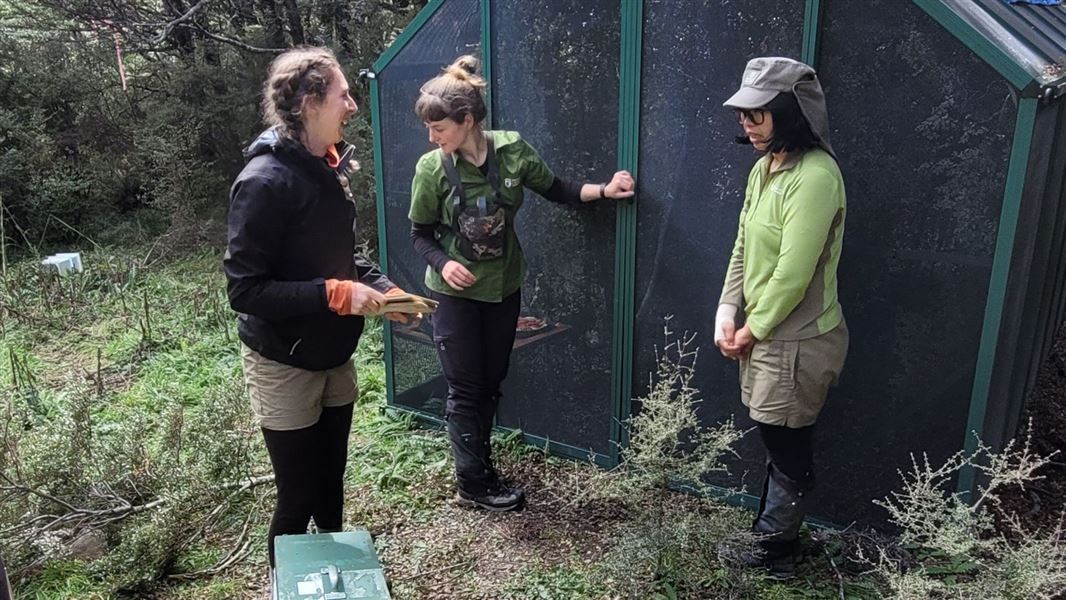Archived content: This media release was accurate on the date of publication.
Date: 05 April 2023
A total of 73 kākāriki karaka, a taonga species for Ngāi Tahu, have been released into Hawdon Valley. The most recent release saw 19 birds introduced to the valley on Saturday, April 1. Earlier releases took place in November, December and January.
The releases were part of the recovery programme for the species, which is run in partnership by Ngāi Tahu and DOC. The birds were bred at The Isaac Conservation and Wildlife Trust, Orana Wildlife Park, and Auckland Zoo.
The Hawdon Valley is in the rohe of Te Ngāi Tūāhuriri Rūnanga, who hold mana whenua over the area.
DOC Kākāriki Karaka Operations Manager Wayne Beggs says kākāriki karaka were previously found in the Hawdon Valley, but the population had declined due to predation to the point where monitoring in 2021 and 2022 was unable to detect any in the valley.
Predator control efforts, including through a Jobs for Nature-funded predator trapping programme and large-scale operations using aerially applied 1080, reduced predator numbers to the point where it is safe for kākāriki karaka to be reintroduced.
Wayne says the birds released this summer have already begun breeding in the valley.
“The field team were delighted to find chicks in a nest in March, the first time kākāriki karaka chicks have been found in the Hawdon since 2015.
“Because they nest and roost in tree holes, kākāriki karaka are particularly vulnerable to predators like rats and stoats. As they are only found in a few sites, establishing new wild populations is crucial for the species’ recovery.”
Te Rūnanga o Ngāi Tahu Kākāriki Karaka Species Recovery Representative Yvette Couch-Lewis says the Hawdon Valley is once again becoming a safe haven for the critically endangered manu.
“When we arrived on site for the latest release the air was already filled with the waiata of kākāriki karaka welcoming their extended whānau to the forest – haere mai.
“These manu have been bred in captivity and do not know the wild. But taking to the skies for the first time, they can stretch their wings and soak in the new smells and sounds of their new home, while feeling reassured that other kākāriki karaka are nearby.”
“A larger population will help to secure the future of kākāriki karaka in the Hawdon Valley, and the coming breeding season will strengthen their whakapapa lines,” says Yvette.
A four-year Jobs for Nature project that started in 2020, operated in partnership by Ngāi Tahi and DOC, has increased predator control and monitoring for kākāriki karaka, aiming to prevent the species’ extinction.
Predator control work in Hawdon Valley has also benefitted other threatened species such as whio and mohua, which have both been seen breeding in the area this summer.
Background
Kākāriki karaka/orange-fronted parakeet are critically endangered, with less than 400 mature adults in the wild.
They were once commonplace across throughout New Zealand, but their distribution decreased rapidly over the last century. They have twice been declared extinct and then rediscovered.
They are currently found in the Hurunui South Branch in Lake Sumner (Hoka Kura) Forest Park, the Hawdon Valley in Arthur’s Pass National Park, the Brook Waimārama Sanctuary in Nelson, and on predator-free Ōruawairua/Blumine Island in the Marlborough Sounds.
The recovery programme works closely with partners such as The Isaac Conservation and Wildlife Trust, Orana Wildlife Park and Auckland Zoo. Their captive breeding programme work is vital to the survival of the species. MainPower, Christchurch Helicopters and Canterbury University also support the programme.
A boom-and-bust species, kākāriki karaka numbers can naturally increase rapidly when environmental conditions are good but can also naturally decline rapidly when they are not.
Their main threats are introduced predators and habitat destruction. Kākāriki karaka are especially at risk from rat and stoat plagues following beech forest masts (mass seeding) – for example, one valley population declined by 85% due to a rat plague in 2001.
The Government’s Jobs for Nature programme is a $1.219 billion COVID-19 recovery investment which aims to benefit New Zealand’s environment, people and regional communities.
Contact
For media enquiries contact:
Email: media@doc.govt.nz
